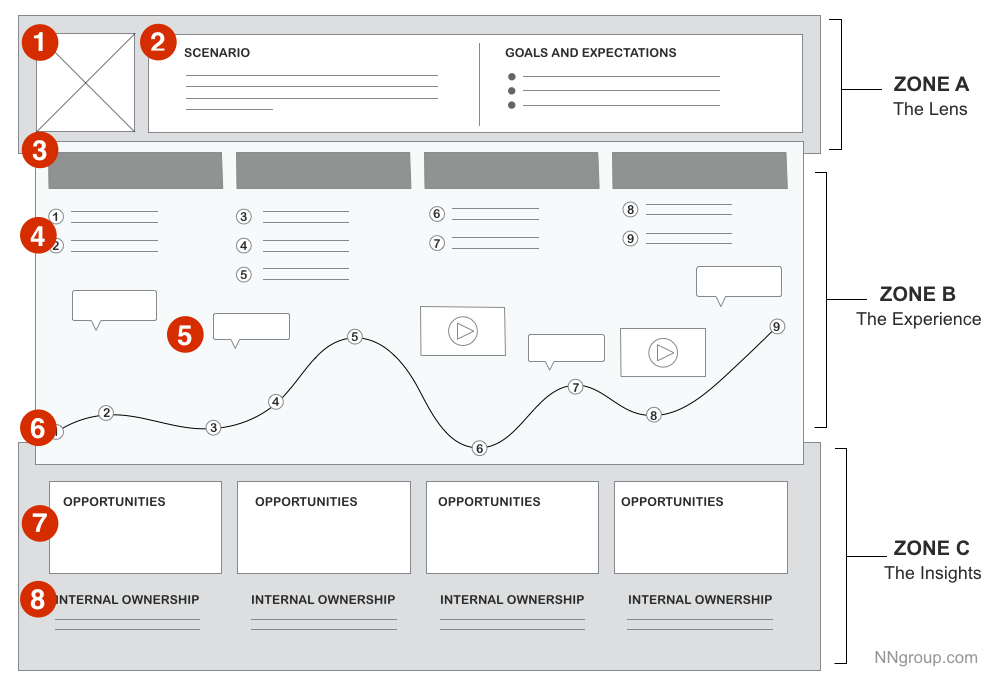- Created by Unknown User (ad6332), last updated by Unknown User (ki8431) on Apr 23, 2019 3 minute read
You are viewing an old version of this page. View the current version.
Compare with Current View Page History
« Previous Version 38 Next »
What is a Customer Journey Map?
“Walking a mile in another man’s shoes”. Customer Journey Mapping is a document; a layout of the customer’s experience with a product, service company or brand over time and through multiple avenues. It is a way for you to see the overall effect of your product/service/company through the eyes of your customer.
Why Should You Use a Customer Journey Map?
As the providers of a product or service, we tend to see the process from our point of view only. We can be unaware of what emotions the customer is experiencing and what part of the journey is the catalyst for those feelings. Emotions are the motivating force of many actions and choices.
Customer Journey Mapping provides us with valuable insight into the customers’ emotions. This is the platform from which we can build develop improvements to enhance the customer experience, guide them through their journey and ultimately help them to achieve their goal in interacting with us or our product.
How Do We Do This?
There are various additions or modifications on how one can produce a Customer Journey Map. However the basic steps to developing an effective Customer Journey Map are as follows:
- Identify the Persona/Point of view: There can be numerous types of users who come into contact with your product or service. The Customer Journey Map should focus on one.
- Identify the Scenario/Goal: Choose one scenario or one goal which would cause your previously identified Persona to interact with your product/service.
- List the Stages/Phases: Based on the Scenario/Goal you’ve identified, list all the stages of the journey that the Persona would take to reach their Goal. It is important to list these from the customer’s perspective and not your own.
- List Actions, Mindsets and Emotions: The key component of the story being told by the journey map is what the Persona is doing, thinking and feeling. Under each phase list the actions the customer is taking along with the associated thoughts and feelings. This information should be gathered from research collected through methods such as Contextual Inquiries, Field Data and Diary Studies.
- List Touchpoints and Channels: The map should correlate all touchpoints and channels with the goals and/or actions of the customer. This helps to identify areas of potential communication/service breakdowns.
- Identify Opportunities for Improvement: Use the insight you gathered to point out occasions where you can improve the customer experience and assist them in accomplishing their goal.
Microlearning
How To Create A Customer Journey Map
UX Mastery Megan Grocki breaks down what a customer journey map is, and how to create one for your next user experience design project. Illustrations by Robin Cave; music by http://podingtonbear.com
Customer Journey Maps – the Why and What of Journey Maps (2018)
Customer journey maps are an important tool to improve customer experience with a product, service or brand. In this video you learn how you can use customer journey maps to better understand your customer and to trigger product innovations. You learn the most important basics of customer journey mapping and get to know some of the essential details of journey maps.
HCD PROCESS
 TEMPLATES
TEMPLATES
Customer Journey Map Template 1
Customer Journey Map Template 2
HCD Toolkit > User Journey.docx
HCD Toolkit > user_journey.vsd
KEY TERMS
Persona/Point of View: A type of customer that interacts with your product/service.
Scenario/Goal: The situation which is the ultimate reason that the customer will interact with your product/service.
Touchpoint: Each instance in which a customer “touches” or interacts with your product/service during the Scenario is a touchpoint.
Channel: The method of communication or interaction with which the customer is able to interact with the product or service.
- No labels
